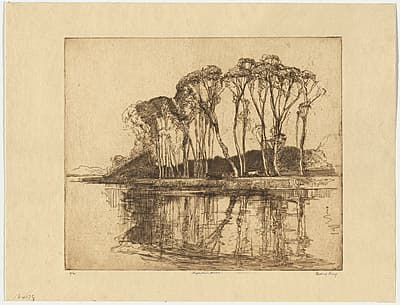
Sydney
LONG
Australia
1871
–
London
1955
England, Europe 1910-21; Australia 1921- 22; England 1922-25; Australia 1925-52; England from 1952
26.7 (h) x 31.6 (w) cm
5/50 , published state , edition of 50 , no manufacturer's mark
Signed lower right below plate-mark in black pencil, 'Sydney Long'. Titled lower centre below plate-mark in black pencil, '.Reflections Avoca.' Inscribed with edition details lower left below plate-mark in black pencil, '5/ [illeg.]'.
Reference: Mendelssohn (1979), 85; Paul (1928), 87 National Gallery of Australia, Canberra NGA 1977.9.105 The Stephen Collection, purchased 1976. Reproduced with the kind permission of the Ophthalmic Research Institute of Australia
- J.W.F. Stephen, who formed a definitive collection of the etched work of Sydney Long. J.A.C. Stephen, the artist’s son, by descent. Purchased by the Australian National Gallery, from J.A.C. Stephen, Sydney, 1977.
With deft mark-making, Long articulated the gentle sublimity of the reflected scene as it settled upon the water’s glassy surface. Just as Long was ‘awed by the vast mirror’ of the lake, so was Walter D. White, in his poem published in the Sydney Morning Herald in 1937, ‘The lake – Avoca’.
The mirrored loveliness of dawn – / The wonder of the eastern sky/ When daybreak, like a startled fawn,/ Quick moving, fills with witchery/ The earth and sea…/ Holding the captured beauty of the skies,/ Avoca lies!/ The lake a golden, glittering net,/ Has snared rare gems from earth’s proud/ coronet.
Returning to the reflection as a compositional device for arresting decoration within the landscape, Long expressed the quiet solitude of the scene. Loose hatching, worked into the copper plate with easy, gestural sweeps, captures the silky reflection of the towering trees that line the shore of Avoca Lake. The compelling majesty of the pale trunks, crowned by delicate plumes of foliage, is enhanced by their mirrored double. As in Rose Bay in 1908 (cat 94), the humanity of the space is conveyed through the presence of cows that quietly graze along the narrow strip of land that divides lake and sky.
A copy of Reflections, Avoca was first exhibited in 1928 at the ‘Eighth annual exhibition of the Australian Painter–Etchers’ Society’, Sydney, 8–20 June (52), prompting a critic to admire the ‘exquisitely simple line of “Reflections, Avoca”’ (SMH, 12 December 1928). Copies of the etching are held by the Art Gallery of New South Wales and the Tasmanian Museum and Art Gallery.
Emma Kindred
With deft mark-making, Long articulated the gentle sublimity of the reflected scene as it settled upon the water’s glassy surface. Just as Long was ‘awed by the vast mirror’ of the lake, so was Walter D. White, in his poem published in the Sydney Morning Herald in 1937, ‘The lake – Avoca’.
The mirrored loveliness of dawn – / The wonder of the eastern sky/ When daybreak, like a startled fawn,/ Quick moving, fills with witchery/ The earth and sea…/ Holding the captured beauty of the skies,/ Avoca lies!/ The lake a golden, glittering net,/ Has snared rare gems from earth’s proud/ coronet.
Returning to the reflection as a compositional device for arresting decoration within the landscape, Long expressed the quiet solitude of the scene. Loose hatching, worked into the copper plate with easy, gestural sweeps, captures the silky reflection of the towering trees that line the shore of Avoca Lake. The compelling majesty of the pale trunks, crowned by delicate plumes of foliage, is enhanced by their mirrored double. As in Rose Bay in 1908 (cat 94), the humanity of the space is conveyed through the presence of cows that quietly graze along the narrow strip of land that divides lake and sky.
A copy of Reflections, Avoca was first exhibited in 1928 at the ‘Eighth annual exhibition of the Australian Painter–Etchers’ Society’, Sydney, 8–20 June (52), prompting a critic to admire the ‘exquisitely simple line of “Reflections, Avoca”’ (SMH, 12 December 1928). Copies of the etching are held by the Art Gallery of New South Wales and the Tasmanian Museum and Art Gallery.
Emma Kindred
With deft mark-making, Long articulated the gentle sublimity of the reflected scene as it settled upon the water’s glassy surface. Just as Long was ‘awed by the vast mirror’ of the lake, so was Walter D. White, in his poem published in the Sydney Morning Herald in 1937, ‘The lake – Avoca’.
The mirrored loveliness of dawn – / The wonder of the eastern sky/ When daybreak, like a startled fawn,/ Quick moving, fills with witchery/ The earth and sea…/ Holding the captured beauty of the skies,/ Avoca lies!/ The lake a golden, glittering net,/ Has snared rare gems from earth’s proud/ coronet.
Returning to the reflection as a compositional device for arresting decoration within the landscape, Long expressed the quiet solitude of the scene. Loose hatching, worked into the copper plate with easy, gestural sweeps, captures the silky reflection of the towering trees that line the shore of Avoca Lake. The compelling majesty of the pale trunks, crowned by delicate plumes of foliage, is enhanced by their mirrored double. As in Rose Bay in 1908 (cat 94), the humanity of the space is conveyed through the presence of cows that quietly graze along the narrow strip of land that divides lake and sky.
A copy of Reflections, Avoca was first exhibited in 1928 at the ‘Eighth annual exhibition of the Australian Painter–Etchers’ Society’, Sydney, 8–20 June (52), prompting a critic to admire the ‘exquisitely simple line of “Reflections, Avoca”’ (SMH, 12 December 1928). Copies of the etching are held by the Art Gallery of New South Wales and the Tasmanian Museum and Art Gallery.
Emma Kindred
